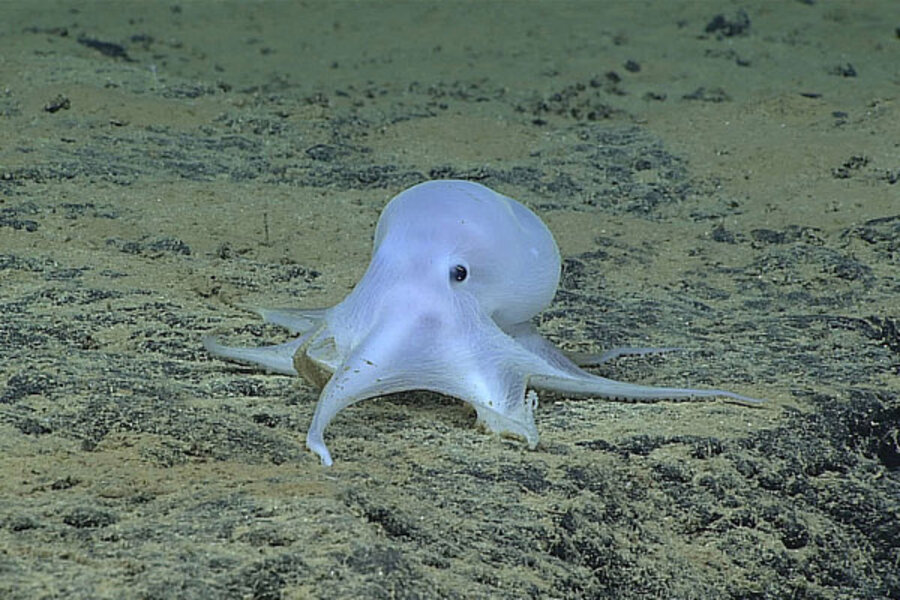'Casper' the octopus threatened by deep sea metal mining
Loading...
Your smartphone might someday put Casper at risk, scientists say.
A study published Monday in the journal Current Biology suggests that deep-sea octopuses, such as the ghostly "Casper" discovered earlier this year, could be threatened by deep sea mining. Researchers have observed similar octopuses laying eggs on clumps of precipitated metal called manganese nodules, which take millions of years to develop. Manganese is used in cellphones and computers, and though ocean mining hasn’t yet begun in earnest, increased demand may draw manufacturers to the deep.
“Many of these metals are not available easily on land at a good price,” lead author Autun Purser, of the Alfred Wegener Institute for Polar and Marine Research in Germany, told the Los Angeles Times. “This is driving research into how to get these metals out of the sea.”
In March, National Oceanic and Atmospheric Administration (NOAA) researchers spotted an unusual creature from the agency’s remotely operated Deep Discover vehicle. There, some 13,000 feet below sea level in Hawaii, a strange white octopod hovered just over the seafloor.
“This animal was particularly unusual because it lacked the pigment cells, called chromatophores, typical of most cephalopods, and it did not seem very muscular,” NOAA zoologist Michael Vecchione said in a statement after the initial discovery. “This resulted in a ghostlike appearance, leading to a comment on social media that it should be called Casper, like the friendly cartoon ghost.”
The Christian Science Monitor’s Lucy Schouten reported:
The octopod's suckers were arranged in one, rather than two series along its arms, and it had no fins, both characteristics generally reserved for shallow-water octopuses. Its pale appearance and lack of muscle, probably because so little food is available at those depths, are representative of its deep-water home. The creature did have eyes, however.
Researchers suspect that the octopus represents a new species, and possibly a new genus as well....
Though this ghostly creature appears to be unique, researchers have identified similar octopuses at comparable depths. Dr. Purser and his colleagues compared 29 such observations, each recorded on video by remotely operated vehicles, and noted that two appeared to guard their eggs.
In both cases, the individuals had stashed their eggs on the stems of dead sponges that had grown on manganese nodules.
“The nodules served as the only anchoring point for the sponges on the otherwise very muddy seafloor,” Purser said in a statement. “This means that without the manganese nodules, the sponges would not have been able to live in this spot, and without sponges the octopuses would not have found a place to lay their eggs.”
Deep sea octopods are believed to be watchful parents, guarding their eggs for the entire incubation period. That’s not such an impressive commitment for certain land animals – a chicken egg, for example, takes less than a month to hatch – but the process is quite different in near-freezing deep sea temperatures. At 37 degrees Fahrenheit (3 degrees Celsius), it takes some octopuses four years of continuous brooding to hatch. At 13,000 feet below sea level, where temperatures can drop to just one degree C (34 degrees F), it could take even longer.
Though some octopuses are known to lay hundreds of eggs, the observed broods contained just about 30 large eggs. Paired with the exceptionally long period of embryonic development, that could make life very tenuous for Casper and its cousins.
Non-brooding octopuses were also observed near the nodules, researchers said, which might suggest that these animals spend most of their life cycles around them.
“The video footage indicates that the animals have cleaned the seabed around the nodules. It probably looks like that because the animals have been filmed using their arms to dig into the sediment around the nodules probably in search for food,” co-author Henk-Jan Hoving, of the GEOMAR Helmholtz Centre for Ocean Research, said in a statement.
And octopuses aren’t the only form of deep sea life threatened by mining.
In the late 1980s, German researchers removed a series of manganese nodules from the Peru Basin at part of the DISCOL experiment, which sought to observe how extraction and disturbance affected the surrounding ecosystem. Twenty-six years later, researchers returned to the spot.
“The removal of the manganese nodules at that time caused the community of animals that are attached to the seafloor, which also includes sponges, to almost fully collapse,” authors wrote in the new study. “Even 26 years later many animal populations have not yet recovered."






